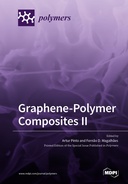Explore

Graphene-Polymer Composites II
0 Ungluers have
Faved this Work
Login to Fave
Graphene-polymer nanocomposites continue to gain interest in diverse scientific and technological fields. Graphene-based nanomaterials present the advantages of other carbon nanofillers, like electrical and thermal conductivity, while having significantly lower production costs when compared to materials such as carbon nanotubes, for instance. In addition, in the oxidized forms of graphene, the large specific area combined with a large quantity of functionalizable chemical groups available for physical or chemical interaction with polymers, allow for good dispersion and tunable binding with the surrounding matrix. Other features are noteworthy in graphene-based nanomaterials, like their generally good biocompatibility and the ability to absorb near-infrared radiation, allowing for the use in biomedical applications, such as drug delivery and photothermal therapy.This Special Issue provides an encompassing view on the state of the art of graphene-polymer composites, showing how current research is dealing with new and exciting challenges. The published papers cover topics ranging from novel production methods and insights on mechanisms of mechanical reinforcement of composites, to applications as diverse as automotive and aeronautics, cancer treatment, anticorrosive coatings, thermally conductive fabrics and foams, and oil-adsorbent aerogels.
This book is included in DOAB.
Why read this book? Have your say.
You must be logged in to comment.
Rights Information
Are you the author or publisher of this work? If so, you can claim it as yours by registering as an Unglue.it rights holder.Downloads
This work has been downloaded 107 times via unglue.it ebook links.
- 107 - pdf (CC BY) at Unglue.it.
Keywords
- Adhesives
- biobased polymer nanocomposites
- cellulose nanocrystal
- cellulose nanofibers
- cohesive zone model
- composite fiber
- conducting polymer
- Corrosion
- Crystallization
- Cytotoxicity
- directional freeze-drying
- DNA Damage
- elastic recovery
- electrical conductivity
- electrospinning
- elongational flow
- fabric
- Finite element method
- Graphene
- graphene nanoplatelets
- graphene oxide
- graphene oxide–platinum nanoparticles nanocomposites
- graphene polymer matrix composite
- graphene-polymer nanocomposite
- graphene/polymer interface
- Halpin–Tsai
- Hydrogen bond
- in situ melt polycondensation
- interfacial bonding
- Leis
- light emitting diode
- Mechanical Property
- mitochondrial membrane potential
- Molecular Dynamics
- Morphology
- n/a
- oil absorption
- Oxidative Stress
- PANI
- Phototherapy
- poly(trimethylene terephthalate)
- polyamide 66
- polyethylene glycol
- polymer composite fiber
- polypropylene
- polysulfone foams
- Polyvinyl Alcohol
- prostate cancer
- recycled rubber
- regressive softening law
- scCO2
- SEM
- Technology, engineering, agriculture
- Technology: general issues
- thermal conductivity
- thermal reduction
- Thermal stability
- tortuosity
- toughening mechanisms
- tung oil
- unsaturated polyester resins
- water vapor induced phase separation
Links
DOI: 10.3390/books978-3-0365-1677-6Editions

